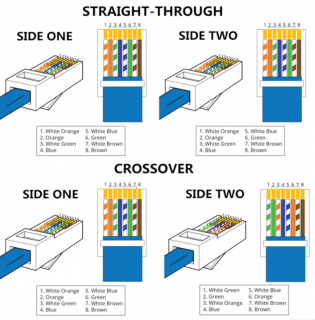Straight-Through vs. Crossover Cable
srijeda , 04.01.2017.It is well known that network patch cable can be commonly wired as straight-through or crossover cable, used for data transmission. Both of these two network patch cables are made up of four pairs of high performance twisted wires with different colors, terminated by the RJ45 keystone jacks at each side of the cables. As for their applications, they are designed for serving different aims, with different wire arrangements inside their cables, which will be introduced in the following text for guiding you to pick the most proper one for deploying you network.
Different Wiring Standards for Wire Arrangements
Before discussing the differences between the straight-through and crossover cable, it is necessary to introduce two wiring standards, T568A and T568B, for better understanding the different wire arrangements in each kind of the cable. These two kinds of wiring standards are recognized by ANSI, TIA and EIA for wiring the network patch cables. Generally, the T568B wiring standard is more widely used than the T568A wiring standard, as the default wiring scheme for twisted pair structured cabling. If you are unsure of which to use, then choose T568B to arrange the wires inside the cable.
In general, there are eight colored wires in a straight-through or crossover cable, which should be arranged according to the corresponding order of the wiring standard T568A or T568B. That’s to say, the wires with different colors should be terminated in the right positions of the RJ45 keystone jack where the wire colors and the colors in the RJ45 keystone jack are the same, as shown in the figure above.
Comparison of Straight-Through and Crossover Cable
When choosing the network patch cable in the store, you’ll easily find the straight-through cable that is commonly used to connect computers to hubs or switches. While the crossover cable with the function of connecting a computer to another computer should be a little hard to find since this kind of network patch cable are not so commonly used as the previous one. But what are the differences between the straight-through and crossover cable? Let’s talk about this topic.
Different Wire Arrangements
As mentioned above, these two kinds of network patch cables have different wire arrangements. For a straight-through cable, there should be only one wiring standard used. It means that both ends of one straight-through cable can be only wired according to T568A wiring standard or T568B wiring standard. Since T568B wiring standard is more popular, here offers the example of a straight-through cable with T568B wiring standard in the following figure. As for the crossover cable, it is designed with two wiring standards in both ends of the cable. In simple words, if there is a RJ54 keystone jack with T568A wiring standard in one end of the crossover cable, there must be a RJ54 keystone jack with T568B wiring standard in the opposite end, as shown in the following figure.
Different Applications
The two kinds of network patch cables are available in the market, used for different applications. As for the straight-through cable, it is applied in local area networks to connect different kinds of devices, for instance, connect a computer to a switch/hub's normal port or a cable/DSL modem's LAN port. It can be an alternative to wireless connections where one or more computers access a router through a wireless signal. As for the crossover cable, it's usually used to connect same type of devices, such as, connect two computers directly, connect two switches/hubs by using normal port in both switches/hubs.
Conclusion
After discussion, we can concluded that the straight-through and crossover cable are designed with different arrangements, serving for different applications. The straight-through cable is usually used for connecting two different kinds of devices, while the crossover cable is highly recommended in the applications where same kind of devices need to be connected. If you want to distinguish the two kinds of cables, you can just check the color orders for the wires inside the RJ45 keystone jacks at both ends of the cables. If the color orders of the wires are the same on both ends, it means the network patch cable is a straight-through cable. If not, it must be a crossover cable or there may be a wiring error in the cable.
komentiraj (0) * ispiši * #


